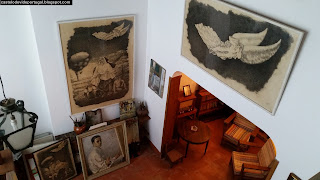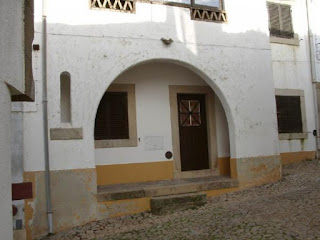GOOGLE MAPS: OPEN MAP
António Ventura Porfírio was born in Castelo de Vide on August 26, 1908. A painter and curator of the National Palace of Queluz, Mestre Porfírio is today remembered for the significant role played in the cultural context of this Alentejo village, actively collaborating in the intellectual life, stimulating the young artists, or integrating city executives. His training began in the 1920s at the School of Fine Arts in Lisbon, where he spent two years working in the atelier of the architect Ernesto Korrodi in Leiria, finishing Fine Arts in Porto. Already in the thirties he participated in the group "Mais Além", one of the rare ones, if not the only manifestation in the scope of the Plastic Arts, of the aesthetics and of the spirit of Presence. The contact with Alberto Serpa, José Régio, Adolfo Casais Monteiro, Augusto Gomes, Abel de Moura, or Basto Fabião, outstanding figures in the intellectual life of Porto, were decisive in their formation. At that time he developed an original painting, very marked by Vasquez Dias, for his stay in Madrid, and also for his contact with Belgian expressionism in Brussels. The following decades were characterized by intense activity as Conservative of the National Palace of Queluz, place that occupied during about thirty-three years. It was already like conservative of the Palace that began the construction of the house and gardens in Castle of Vide, in the years of 1936-37. The house, built from scratch on grounds adjacent to his grandfather's, resulted from a sketch done by the painter, and final project of the architecture office of António Pereira. The gardens, strongly influenced by the experience acquired in Queluz, present a great diversity of vegetal species (of the region and exotic), that develop in a succession of terraces of small dimension. Located on the slope of Outeirinho da Torrinha, this rural area within the urban network allows a privileged view of the slope that descends from the castle to the source of the village, where the Jewish quarter was located. Resuming the career of the painter, the drawing strongly marked the sixties, and between 1958 and 1968, Ventura Porfírio dedicated himself to the Abstract Experiences. The famous portrait of José Régio Poeta de Deus and Debo, of 1958, became, therefore, a work of turning, beginning a very significant period of his career. Finally, the great work that Ventura Porfírio occupied for more than ten years stands out - the mural paintings of the Noble Hall of the Town Hall of Castelo de Vide, finished in 1990. Of all these experiences is witness to his house, where the artistic collection consisting of about four thousand drawings, hundreds of paintings by national and foreign authors, furniture of historical value, among others (CMCV) is well evidence of eighty-eight years dedicated to art. (Rosário Carvalho)
António Ventura Porfírio nasceu em Castelo de Vide no dia 26 de Agosto de 1908. Pintor e conservador do Palácio Nacional de Queluz, o Mestre Porfírio é hoje recordado pelo significativo papel desempenhado no contexto cultural desta vila alentejana, colaborando activamente na vida intelectual, estimulando os jovens artistas, ou integrando executivos camarários. A sua formação teve início nos anos 20 na Escola de Belas Artes de Lisboa, estagiando dois anos mais tarde no atelier do arquitecto Ernesto Korrodi em Leiria, e terminando Belas Artes no Porto. Já nos anos trinta participa no grupo "Mais Além", uma das raras, se não a única manifestação no âmbito das Artes Plásticas, da estética e do espírito de inquietação Presencista. O contacto com Alberto Serpa, José Régio, Adolfo Casais Monteiro, Augusto Gomes, Abel de Moura, ou Basto Fabião, figuras marcantes na vida intelectual do Porto, foram decisivos na sua formação. Nesta época desenvolveu uma pintura original, muito marcada por Vasquez Dias, pela estadia em Madrid, e ainda pelo contacto com o expressionismo Belga, em Bruxelas. As décadas seguintes pautaram-se por uma actividade intensa como Conservador do Palácio Nacional de Queluz, lugar que ocupou durante cerca de trinta e três anos. Foi já como conservador do Palácio que iniciou a construção da casa e jardins em Castelo de Vide, nos anos de 1936-37. A casa, edificada de raiz em terrenos contíguos aos do seu avô, resultou de um esboço feito pelo pintor, e projecto final do gabinete de arquitectura de António Pereira. Os jardins, fortemente influenciados pela experiência adquirida em Queluz, apresentam uma grande diversidade de espécies vegetais (da região e exóticas), que se desenvolvem numa sucessão de socalcos de pequena dimensão. Localizado na encosta do Outeirinho da Torrinha, este espaço rural no interior da malha urbana permite uma visão privilegiada da encosta que desce do castelo até à fonte da Vila, onde se localizava a Judiaria. Retomando a carreira do pintor, o desenho marcou fortemente os anos sessenta, e entre 1958 e 1968, Ventura Porfírio dedicou-se às Experiências Abstractas. O célebre retrato de José Régio Poeta de Deus e do Diabo, de 1958 tornou-se, pois, uma obra de viragem, dando início a um período bem significativo da sua carreira. Por fim, destaca-se a grande obra que ocupou Ventura Porfírio durante mais de dez anos - as pinturas murais do Salão Nobre da Câmara Municipal de Castelo de Vide, terminadas em 1990. De todas estas vivências é testemunho a sua casa, onde o acervo artístico constituído por cerca de quatro mil desenhos, centenas de pinturas de autores nacionais e estrangeiros, mobiliário de valor histórico, entre outros (CMCV) é bem uma evidência de oitenta e oito anos dedicados à arte. (Rosário Carvalho)


















